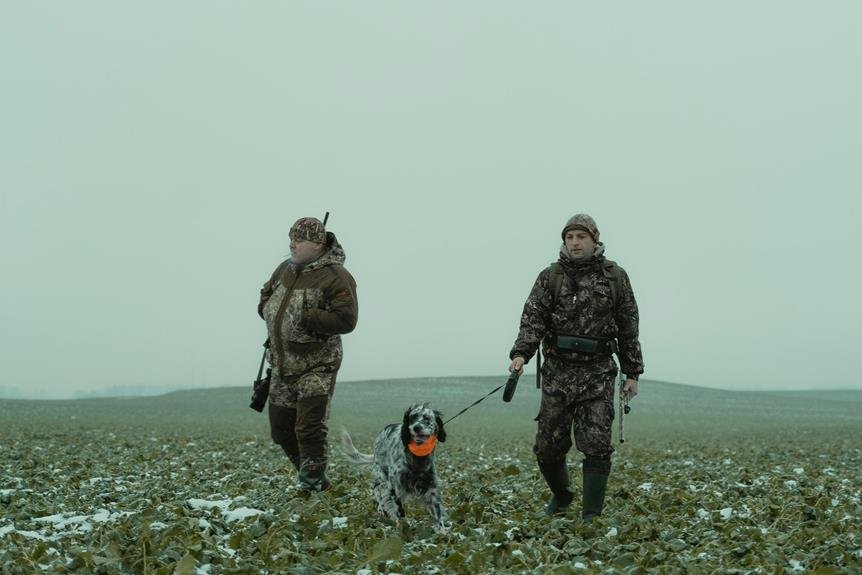
When bow hunting, make sure to inspect your equipment regularly, be cautious while shooting, stay alert to your surroundings, handle arrows carefully, and prepare for emergencies. Your safety is crucial for a successful hunting experience.
Equipment Inspection and Maintenance
When inspecting and maintaining your hunting equipment, ensure that all parts are in proper working condition. Before heading out to the field, take a moment to check your bow for any signs of wear or damage. Make sure the string is free of fraying and the limbs aren't cracked. Inspect the arrows for straightness and any defects that could affect their flight. Checking your broadheads for sharpness is crucial for a clean and ethical kill. It's also essential to examine your bow sight and rest to guarantee they're securely attached and aligned correctly.
Regularly cleaning your equipment after each use will help prolong its lifespan and ensure optimal performance. Use a damp cloth to wipe down your bow and arrows, removing any dirt or debris that could affect their function. Lubricate moving parts, such as the arrow rest or sight adjustment knobs, to prevent rust and maintain smooth operation. By taking the time to inspect and maintain your hunting gear, you aren't only ensuring your safety but also maximizing your chances of a successful hunt.
Safe Shooting Practices
Practice safe shooting by always verifying your target and what lies beyond it before releasing your arrow. Ensuring your shot has a clear path is crucial for a responsible bow hunter.
Take the time to identify your target accurately. It's vital to distinguish between game animals and other objects that may be in your line of sight. Never take a shot if you're uncertain about what's beyond your target. Be aware of any hikers, fellow hunters, or structures that could be in the background.
Your focus should be on a clean shot that poses no risk to anyone or anything beyond your target. Remember, once you release your arrow, you can't take it back. By practicing safe shooting habits, you not only protect yourself but also promote a culture of responsible hunting.
Awareness of Surroundings
Maintain constant vigilance of your surroundings as a bow hunter to ensure the safety of yourself and others at all times. Being aware of your environment is crucial for a successful and safe hunting experience. Before even setting foot in the field, take a moment to survey the area. Note any potential hazards, such as steep terrain, bodies of water, or other hunters in the vicinity. Keep your head on a swivel while moving through the hunting grounds, scanning for any sudden changes or movements. Wildlife can be unpredictable, so staying alert is key.
Additionally, make sure you're familiar with the hunting regulations and boundaries of the area you're in. Knowing where you're allowed to hunt and ensuring you have a clear line of sight before taking a shot can prevent accidents. By staying aware of your surroundings and practicing good situational awareness, you not only protect yourself but also contribute to a safer hunting environment for everyone involved.
Proper Arrow Handling
To ensure safety while bow hunting, always handle arrows with care and attention to detail. When carrying arrows, make sure they're secured in a quiver or arrow holder to prevent accidental injuries.
Before shooting, inspect each arrow for any signs of damage such as cracks, splinters, or bent shafts. Using damaged arrows can lead to unpredictable flight paths and potential malfunctions.
When nocking the arrow onto the bowstring, ensure it's properly seated and aligned to avoid misfires.
When retrieving arrows from a target or the ground, grasp them firmly but gently to prevent accidental cuts or injuries from sharp broadheads.
Always store arrows in a safe and organized manner when not in use to prevent damage and ensure they remain in top condition for your next hunting trip.
Emergency Preparedness
When engaging in bow hunting, it's important to have a plan in place for emergency situations to ensure your safety and well-being. Being prepared can make all the difference in unexpected circumstances.
Firstly, always carry a fully stocked first aid kit tailored to the potential injuries you may encounter while bow hunting. This kit should include items such as bandages, antiseptic wipes, tweezers for removing splinters, and any necessary personal medications.
Secondly, make sure to have a reliable means of communication, like a fully charged cell phone or a two-way radio, to call for help if needed. Additionally, inform someone of your hunting plans, including your expected return time and location. In case of an emergency, this information can be crucial for search and rescue teams.
Conclusion
Remember, safety should always be your top priority when bow hunting. By thoroughly inspecting and maintaining your equipment, practicing safe shooting techniques, staying aware of your surroundings, handling arrows properly, and being prepared for emergencies, you can greatly reduce the risk of accidents in the field.
Always remember to follow these precautions to ensure a safe and enjoyable hunting experience. Stay safe out there!




